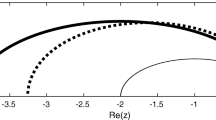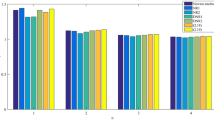Abstract
After introducing briefly the principles of theerror linearization method, which is able to determine the coefficients of the first order error approximation, a collection of examples is presented to demonstrate its efficiency as a test bench for analyzing numerical algorithms. These examples illustrate the propagation of initial errors, the effect of cancellation, the easy location of the most unstable parts of an algorithm, calculation of condition numbers, approximating the statistical behavior of accumulated errors and the convergence of iterative methods.
Similar content being viewed by others
References
I. Babuska,Numerical stability in mathematical analysis, Information Processing 68, North-Holland, Amsterdam (1969), 11–23.
G. H. Golub,Bounds for the round-off errors in the Richardson second order method, BIT 2 (1962), 212–223.
J. Larson and A. Sameh,Efficient calculation of the effects of roundoff errors, ACM Trans. Math. Software 4 (1978), 228–236.
J. Larson and A. Sameh,Algorithms for roundoff error analysis — a relative error approach, Computing 24 (1980), 275–277.
J. Larson, M. Pasternak and J. Wisniewski, Algorithm 594,Software for relative error analysis, ACM Trans. Math. Software, 9 (1983), 125–130.
S. Linnainmaa,Towards accurate statistical estimation of rounding errors in floating-point computations, BIT 15 (1975), 165–173.
S. Linnainmaa,The Taylor expansion of the accumulated rounding error, BIT 16 (1976), 146–160.
S. Linnainmaa,A set of Algol procedures for analyzing the numerical stability of floating-point computations, Report A-1975-2, Department of Computer Science, University of Helsinki, Helsinki, Finland (1975).
S. Linnainmaa, H. Lokki, E. Ukkonen and I. Verkamo,Algol Elastic, a programming language for analyzing numerical stability and its implementation, Report A-1978-3, Department of Computer Science, University of Helsinki, Helsinki, Finland (1978).
S. Linnainmaa,A Fortran implementation of the error linearization method for automatic error analysis, Report A-1982-3, Department of Computer Science, University of Helsinki, Helsinki (1982).
W. Miller,Software for roundoff analysis, ACM Trans. Math. Software 1 (1975), 108–128.
W. Miller and D. Spooner,Software for roundoff analysis II, ACM Trans. Math. Software 4 (1978), 369–390.
W. Miller and C. Wrathall,Software for Roundoff Analysis of Matrix Algorithms, Academic Press (1980).
R. E. Moore,Interval Analysis, Prentice-Hall, Englewood Cliffs, N.J. (1966).
I. A. Stegun and M. Abramowitz,Pitfalls in computation, J. Soc. Industr. Appl. Math. 4 (1956), 207–219.
D. R. Stoutemyer,Automatic error analysis using computer algebraic manipulation, ACM Trans. Math. Software 3 (1977), 26–43.
M. Tienari,A statistical model of roundoff errors for varying length floating-point arithmetic, BIT 10 (1970), 355–365.
M. Tienari,On some topological properties of numerical algorithms, BIT 12 (1972), 409–433.
E. Ukkonen,On the calculation of the effects of roundoff errors, ACM Trans. Math. Software 7 (1981), 259–271.
Author information
Authors and Affiliations
Additional information
Part of this research was done while the author was a visiting scholar at the University of California, Berkeley.
Rights and permissions
About this article
Cite this article
Linnainmaa, S. Error linearization as an effective tool for experimental analysis of the numerical stability of algorithms. BIT 23, 346–359 (1983). https://doi.org/10.1007/BF01934463
Received:
Revised:
Issue Date:
DOI: https://doi.org/10.1007/BF01934463
CR Categories and Subject Descriptors
- G.1.0 (Numerical analysis): General — error analysis, condition, stability
- G.4 (Mathematical Software): Algorithm analysis, portability




